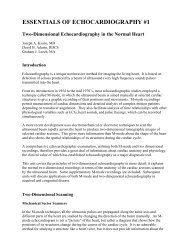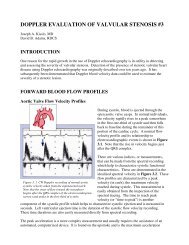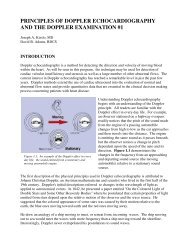ESSENTIALS OF ECHOCARDIOGRAPHY #4 - Echo in Context
ESSENTIALS OF ECHOCARDIOGRAPHY #4 - Echo in Context
ESSENTIALS OF ECHOCARDIOGRAPHY #4 - Echo in Context
Create successful ePaper yourself
Turn your PDF publications into a flip-book with our unique Google optimized e-Paper software.
systemic circuit is, therefore, available. In addition, with a hypoplastic left ventricle, noadequate ventricle is present to pump blood <strong>in</strong>to the aortic arch. This extreme form istermed “hypoplastic left heart syndrome”.Other, less severe forms of ventriculo-great arterial connections also occur. Outflowobstruction of the left heart <strong>in</strong> congenital heart disease can be at subvalvular, valvular, orsupravalvular levels, or may be more distally situated (as <strong>in</strong> coarctation of the aorta or<strong>in</strong>terruption of the aortic arch).Aortic stenosis orig<strong>in</strong>at<strong>in</strong>g from a congenital abnormality of the aortic valve is probably themost common form of aortic valve disease. There is usually symmetric left ventricularhypertrophy, although asymmetric septal thicken<strong>in</strong>g has been described. The aortic valve isfrequently bicuspid (or virtually so, with two large cusps and one very hypoplastic cusp.)Examples of congenital aortic stenosis are presented <strong>in</strong> another unit. In critical cases the leftventricle is often considerable hypertrophied. Mixed stenosis and regurgitation is rarer <strong>in</strong>childhood than <strong>in</strong> adult life.The features of subvalvular obstruction are similar to those seen <strong>in</strong> adults. The most commonform of subvalvular aortic stenosis <strong>in</strong> childhood is a discrete fixed subvalvular narrow<strong>in</strong>gfrequently associated with a membranous r<strong>in</strong>g. Fig. 25 demonstrates a patient with asubvalvular membrane preoperatively, and then after the membrane was surgically removed.The subvalvular membrane is easily recognized on the two-dimensional long-axis view.Symmetric or asymmetric septal hypertrophy may be present and the aortic valve showsabnormal systolic closure and flutter<strong>in</strong>g.Hypertrophic obstructive cardiomyopathy with asymmetric septal hypertrophy does occur <strong>in</strong>childhood, though more rarely than <strong>in</strong> adults. The asymmetric septal hypertrophy is variable<strong>in</strong> degree and position and may be secondary to other lesions, such as coarctation, systemichypertension, right ventricular hypertrophy, or valvular aortic stenosis. The whole trabecularseptum may be <strong>in</strong>volved or only a segment. Outflow tract obstruction is usually associatedwith systolic anterior movement (SAM) of the anterior mitral leaflet and partial midsystolicclosure of the aortic valve. Examples of this entity have been presented <strong>in</strong> another unit.Obstruction of the great arteriesObstruction to flow with<strong>in</strong> the great arteries and distal to the semilunar valves is alsopossible. Most commonly, coarctation of the aorta is encountered as an area of discretenarrow<strong>in</strong>g near the junction of the transverse and descend<strong>in</strong>g aorta (Fig. 26). While thisdiagnosis can be made frequently from the two-dimensional echocardiogram, Dopplermethods have enhanced the reliability of ultrasound to detect this entity. Suprasternal viewsare necessary for proper visualization of the entire aortic arch.Supravalvular aortic stenosis is a rare form of left heart obstruction, commonly associatedwith idiopathic hypercalcemia <strong>in</strong> <strong>in</strong>fancy. The aortic valve is frequently with<strong>in</strong> normalechocardiographic limits. Narrow<strong>in</strong>g of the aortic root can be observed just above the s<strong>in</strong>usesof Valsalva <strong>in</strong> the parasternal long-axis and short-axis views. The severity of left ventricularhypertrophy gives some <strong>in</strong>dication of the degree of aortic narrow<strong>in</strong>g.Other anomalies of the aortic arch are also possible. Interruption of the aortic arch is a rareand highly lethal condition of <strong>in</strong>fancy, which can be diagnosed by two-dimensionalechocardiography from the suprasternal approach. Tubular hypoplasia of the arch as well as








